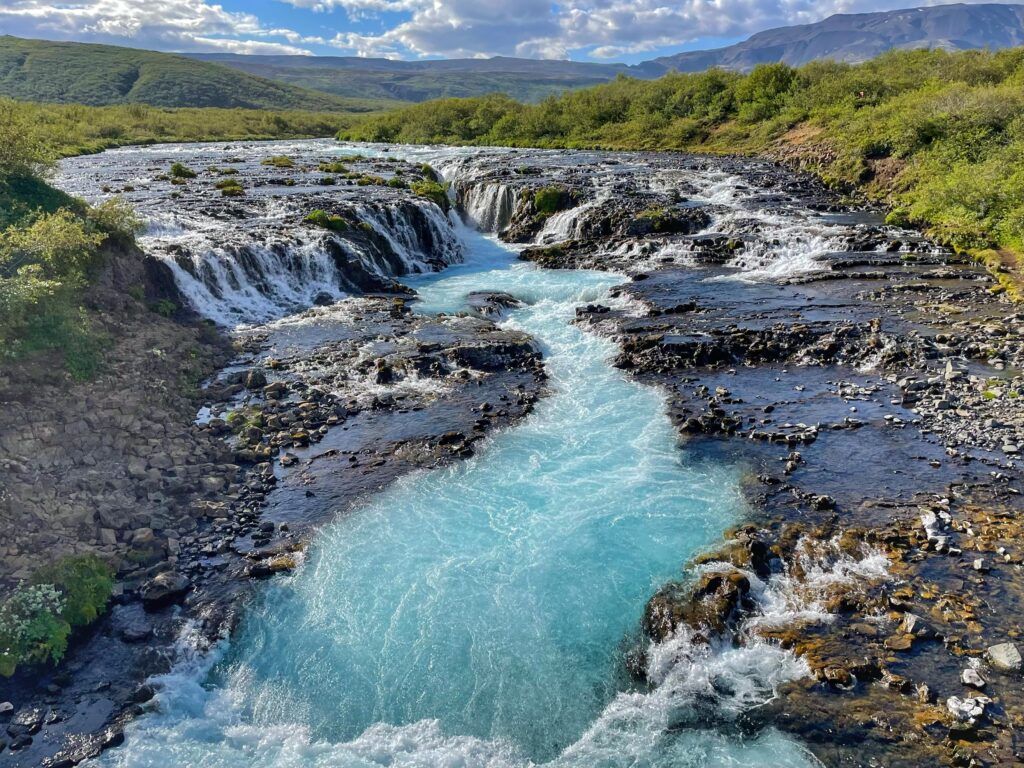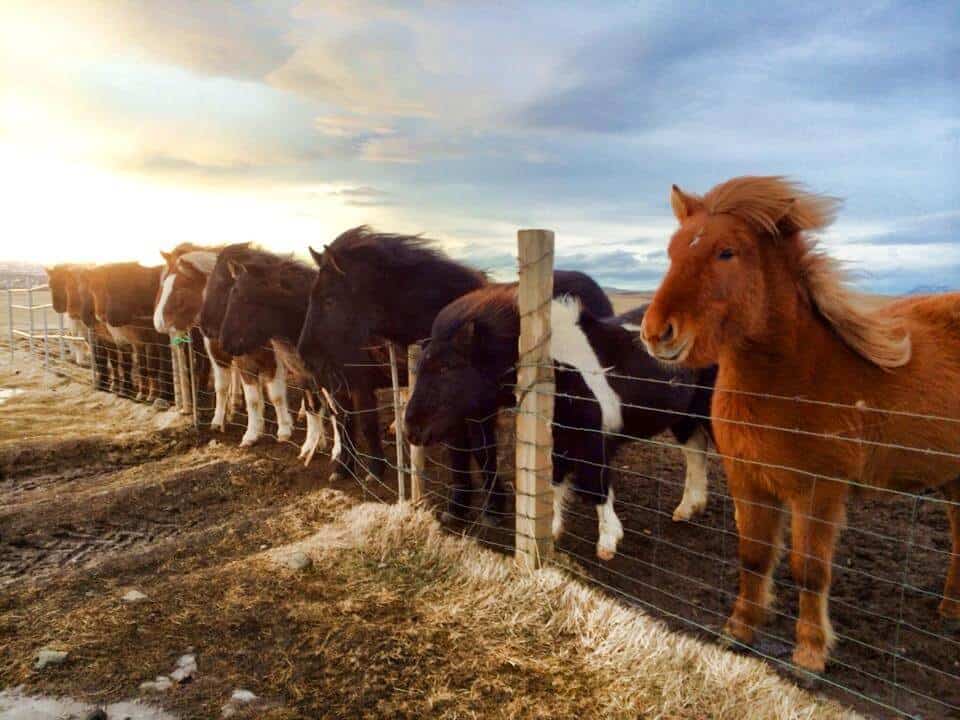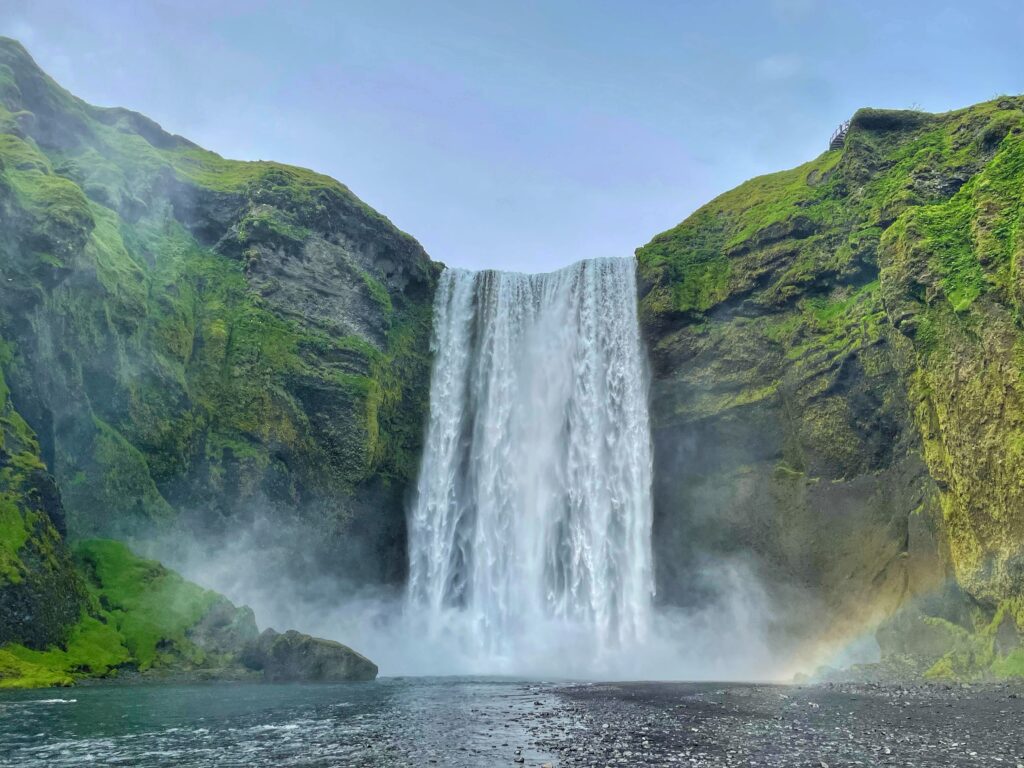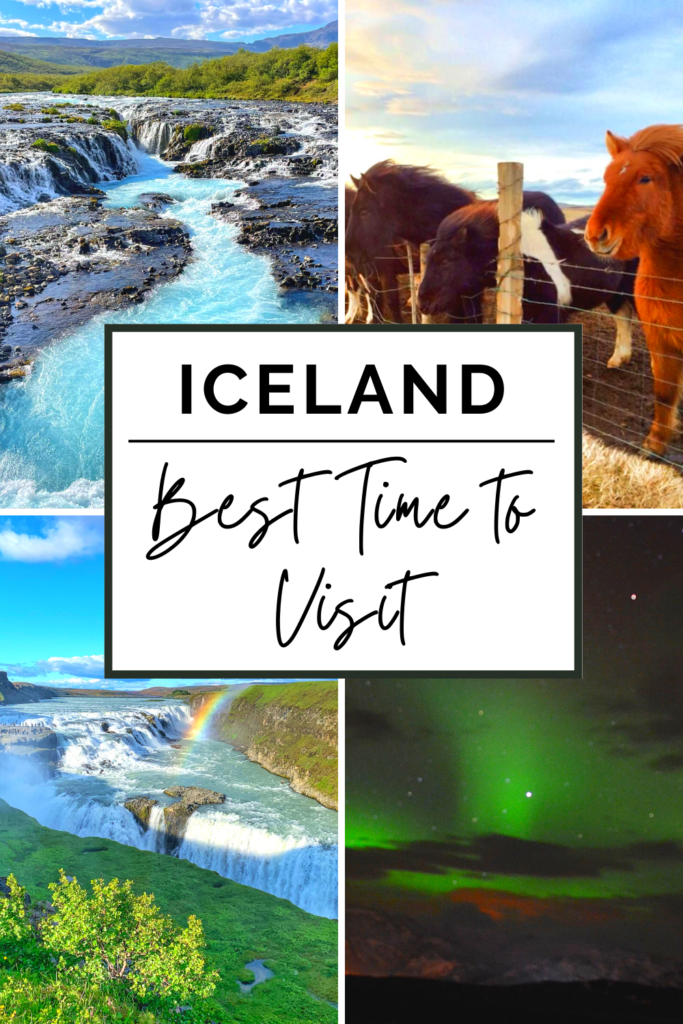The Best Time to Visit Iceland: In-Depth Guide
When is the best time to visit Iceland?
You may only have one chance to visit this incredible country, so I want to help you get the most out of your trip.
We’ll talk about Pros and Cons of summer, winter, spring, and fall, which season caters to your Iceland trip goals, and my experience/advice after visiting in both summer and winter.
Hopefully you’ll feel confident when picking the best time to visit Iceland.
I am obsessed with Iceland. I think most people who visit Iceland fall in love with it. How could you not? Nature’s beauty is on full display everywhere you go. The waterfalls, volcanoes, mountains, ocean, glaciers…. it’s an outdoor lover’s dream. And the Northern Lights? AND Midnight Sun? Honestly, it’s almost unfair to other countries that Iceland is as amazing as it is.
Iceland is the only foreign country I have visited twice. There are so many places to see in this world, I can never really justify going back to the same one. But Iceland is so vastly different in the summer vs the winter that I wanted to visit in both seasons.

Bruarfoss Waterfall in the summer. SO pretty.
Jump to Best Time to Visit Iceland:
My first visit to Iceland was in February. I went alone and had a phenomenal time. I witnessed the Northern Lights, soaked in Iceland’s pools under falling snow, and experienced an Icelandic blizzard.
My second visit to Iceland was in July. My husband and I took our almost 2 year old on her first international trip. We had the best time, and our toddler LOVED it. We spent a lot of time in the countryside, saw so many cool waterfalls, and got to experience the Midnight Sun.
Both trips were awesome, but they were very different. I’m going to share the pros and cons of each season and then let you decide what’s most important to you. Whenever you decide to go, I promise you Iceland will not disappoint.
When is the Best Time to Visit Iceland?
I’ll just say it right away.
The best time to visit Iceland is June through August to experience the Midnight Sun and pleasant weather. The 2nd best time to visit Iceland is October through March to hopefully witness the Northern Lights.
I hope you’ll keep reading to learn when the best time is for YOU to visit Iceland.
Iceland’s Seasons at a Glance
Anyone else forget almost everything they learned in school but can recall that Greenland is actually really icy and cold and Iceland is actually green? Same.
This is sort of true.
Iceland is green. SO GREEN in the summer. But it can be icy and cold too.
Overall, Iceland’s weather is relatively mild. Its average temperature in January is around 30°F and July is around 50°F. Only a 20°F difference. Iceland weather can change quickly too, and you can sometimes experience all 4 seasons in a day. It can get SO windy, which greatly affects how pleasant or unpleasant it is outside.
Winter: October – April
- Highs 39-45°F, Lows 28-34°F
- Daylight Hours
- October: 9 hours
- November: 6 hours
- December: 4 hours
- January: 4 hours
- February: 7 hours
- March: 10 hours
Spring: April – May
- Highs 45-50°F, Lows 32°F.
- Daylight Hours
- April: 15 hours
- May: 18 hours
Summer: June – July/Some of August
- Highs 60-65°F, Lows 45°F
- Daylight Hours
- June/July: 20-22 hours
- August: 16 hours
Fall: End of August – October
- Highs 45-55°F, Lows 37°F
- Daylight Hours
- September: 13 hours
- October: 9 hours

Icelandic horses are only fuzzy in the winter
Let’s Talk about Iceland in the Winter, October-March
Iceland in the winter is pretty magical. Reykjavik is an amazing city to explore, and it’s just lovely when it’s snow-covered and everyone is bundled up walking from colorful building to colorful building. I mean, it’s ICEland, so it feels right to experience cold weather while you’re there. I will say, though, that Iceland in the winter can be risky. Bad weather can cancel tours and shut down roads, it can get REALLY cold, and you aren’t guaranteed to see the Northern Lights.
Also, December and January have only 4 hours of daylight. 4! In a country of amazing nature, that’s a lot of time each day that you can’t experience waterfalls, glaciers, etc.
The Northern Lights can be seen in Iceland from October until the beginning of April.
Pros of Visiting Iceland in the Winter
- You might get to witness the Northern Lights. I don’t have the words to express how unbelievable they are. You’ll likely cry. You’ll be in awe of this world and how incredible it is. I get why people visit in the winter solely for this reason.
- Golden hours. Ya know when the sun is rising or setting and everything is golden and perfect? Lots of this.
- Snow can make nature’s beauty even more stunning.
- It will be less crowded, fewer tourists.
- It is cheaper.
- May have more options for where to stay.
- Less daylight = more partying/going to the bars if that’s what you’re into.
- Their pools are open year-round, and it’s really awesome to sit in a hot, Icelandic pool while snow falls around you.
- You can go skiing, snowmobiling, and ice fishing. Or visit the Ice Caves near Jokulsarlon.
- The horses are fuzzy, only in winter.
Cons of Visiting Iceland in the Winter
- Your tour might get cancelled. I had scheduled a glacier walk and visit to the black sand beach, and instead we went to a museum (bleh). The blizzard made their roads impassable, and it would have been dangerous to hike on a glacier.
- If your goal is to see the Northern Lights, you might be really disappointed if the conditions aren’t right to see them while you’re there. Also, you might spend 2 hours in the middle of the night driving around and sitting in the cold to not even witness the beauty.
- It can be COLD. It’s hard to stay outside for a long time in freezing temperatures, and the main reason to go to Iceland is to be outside. You won’t want to spend as much time gazing at the epic waterfall.
- You don’t have much daylight, so you have limited time to see the beautiful sights.
- Roads may be closed or dangerous, limiting where you can go.
Now Let’s Talk about Iceland in the Summer, June-July/Start of August
Summer in Iceland can be so amazing. While it’s not super warm most of the time, the weather overall is much more pleasant. We still had to wear warm clothes and experienced some cold rain. The Midnight Sun is underrated. You literally have 24 hours per day to explore. Yes, you should sleep sometimes, but you can also walk The Blue Lagoon at midnight or sit in a hot tub and watch the sun “set” then come right back up in the middle of the night. It’s just so cool and really opens up things you can do.
The longest day is June 20th. When we visited at the beginning of July, it never got dark outside. It just felt like dusk for a bit around midnight and then the sun would come up again.

Foxafoss Waterfall with wildflowers in summer
Pros of Visiting Iceland in the Summer
- The Midnight Sun. Unlimited time to do things. And you get a pink sky for a couple hours every night. It’s epic.
- Pleasant weather. You can enjoy the outdoor sights a lot more.
- Camping. If you’re into that.
- Certain areas are only accessible during the summer – like the Highlands and some hikes.
- You don’t have to worry about things getting cancelled/roads being closed due to weather.
- It’s easier to explore more of the country when you don’t have to worry about dangerous roads.
- More things to do: tours, summer festivals, open museums
- WAY better to visit in the summer if you have kids. I don’t know what we would have done if our 2 year old would have only had 4 hours of daylight, especially since the time change really messed with her sleep. With 24 hours of daylight, we could explore whenever it was convenient to us.
- You have a higher chance of seeing puffins and whales.
Cons of Visiting Iceland in the Summer
- You won’t get to see the Northern Lights. Sorry.
- More crowds, busier tourist areas.
- More expensive? Accommodations are likely more expensive, but there are more free things to do with all the daylight/nice weather.
What about visiting Iceland in the Spring or Fall?
These are possibilities too, but you will likely lose either the Northern Lights or the Midnight Sun. Spring and Fall are Iceland’s off-seasons, so you might have a better chance finding cheaper accommodations or finding yourself alone at a waterfall.
Read more on Iceland: Visit The Blue Lagoon for Free and The Best Iceland Itinerary with a Toddler.
Iceland in the Spring, April-May
You won’t get the Midnight Sun, but you could have the chance to experience the Northern Lights if you visit at the beginning of April. If you can’t afford to visit in summer, spring might be your next best option.
Pros of Visiting Iceland in the Spring
- Fewer tourists
- Cheaper accommodations and more availability
- Might see some flowers starting to bloom
- Puffin season! April-August
- Longer days
- Mild weather
Cons of Visiting Iceland in the Spring
- No Midnight Sun
- A lower chance of viewing the Northern Lights
- It can still be pretty cold and snowy at times
Iceland in the Fall, end of August-October
Fall can always be kind of magical, right? Things feel cozy, the leaves are changing, and coffee never tastes so good. Anytime is a good time to visit Iceland, but fall would probably be my last resort on when to visit. If you can make summer or winter work, do one of those.
Pros of Visiting Iceland in the Fall
- Colorful leaves
- Still have a decent amount of daylight
- Fewer tourists in the off-season
- Cheaper accommodations and more availability
- Might see the Northern Lights
- Might experience the first snow of the season
Cons of Visiting Iceland in the Fall
- Might have crappy weather
- No Midnight Sun
- Lower chance of seeing the Northern Lights

Skogafoss Waterfall in the summer. Just insanely pretty.
Best Time to Visit Iceland to See The Northern Lights
While you can never count on seeing The Northern Lights – you need clear skies and solar activity – you must visit in the winter, mid-October to mid-March for a chance to see them. Summer is sunny literally all day/night long, so there is zero chance of seeing the Northern Lights then.
Best Time to Visit Iceland for Fewer Crowds
Spring and Fall will give you the best chance of avoiding crowds.
Winter is less crowded (except the end of December when tourists flock in), but you have less daylight. This means everyone is visiting the popular attractions at the same time.
Summer – especially July and August – is the busiest time in Iceland. With the Midnight Sun and pleasant weather, people love to visit Iceland then. BUT I still believe you can avoid crowds in the summer and make it worth the trip. Visit the popular attractions at odd times… early in the morning or late at night, and you’ll find that you can have some epic views to yourself.
Worst Time to Visit Iceland?
Sorry, but I can’t really answer this. I think one can find Iceland wonderful at any time of the year. Its hidden gems, its magic, its geothermal pools under a pink Midnight Sun or a winter blizzard… Iceland is wonderful any day of the year.
So when is the best time to visit Iceland?
Honestly, I think the best time to visit Iceland is the summer. Yes, the Northern Lights are absolutely incredible, but you aren’t guaranteed to see them. If you only have one chance to visit Iceland, I think the summer offers so much more. Maybe I’m just not a fan of darkness, but I’d rather have light all day and pink skies all night vs 18 hours of darkness every night and maybeee a glimpse of the Northern Lights.
Some last things to consider on the best time to visit Iceland:
- If you have kids, definitely visit in the summer. You won’t have to worry about them being cold, and you’ll have more time to explore. Who wants to spend tons of hours indoors with children on vacation? No thank you.
- If you have a long time to travel, more than 5 days, visit in the summer. It opens up more possibilities, and you’ll have more places to explore.
- If you only have a few nights, maybe try the winter.
- If you’ve read this whole blog, and The Northern Lights are just the most important to you, go in the winter. But if the Midnight Sun sounds awesome, do summer.
- If you have to be really frugal, go in Spring or Fall.
Like I said, you will love Iceland regardless of when you visit. The people are kind, it’s super safe, and it’s BEAUTIFUL. None of this changes based on the season. I hope you go, and I hope you have the best time. Please remember to always Be Kind to Iceland. And make sure you visit The Golden Circle when you go.
Happy Traveling!

Best Time to Visit Iceland – Pin this for later!







Very nicely written article. I found it very informative and very insightful. I plan to visit with my wife this coming year and your article helped us plan for the trip. It is always hard to decide on when to go to see places for there are lots of variables to work around. Our beautiful planet never ceases to amaze during every season she offers us. Thanks (george)
Hi George, thanks so much for the kind comment! Hope you have a great trip!
Hi there! My husband and I are wanting to take our sons (4&6) here, and looks like summer is the time to go! Is there anything to avoid when taking the kiddos that you gleaned from your time here with your daughter?
Hi Jessica! You are going to have an amazing time! Yes, definitely summer with kiddos! It was honestly such a great spot for traveling with kids. Book accommodations well ahead of time; some of the small towns don’t have a lot of options. It’s expensive there, so pack some snacks and things from home.. grocery shop in Reykjavik. I have a bunch of posts on Iceland with a toddler if you want to start here… https://www.nursetonomad.com/tips-for-iceland-travel-with-a-toddler/
Have a great trip!!